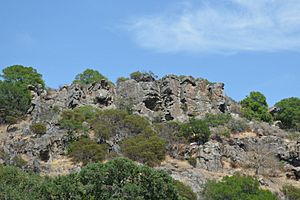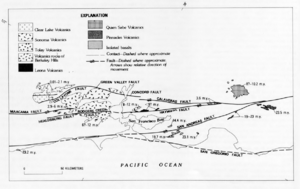Sonoma Volcanics facts for kids
Quick facts for kids Sonoma VolcanicsStratigraphic range: Pliocene |
|
|---|---|

|
|
| Type | volcanic |
| Underlies | Huichica Formation (Pleistocene) |
| Overlies | Neroly Sandstone (Miocene) |
| Lithology | |
| Primary | andesite and rhyolite |
| Other | basalt |
| Location | |
| Region | Napa County and Sonoma County, Northern California |
| Country | United States |
| Type section | |
| Named for | Sonoma Valley |
| Named by | Osmont (1905), and Dickerson (1922) |
The Sonoma Volcanics are a group of rocks formed by ancient volcanoes. They are found across Napa and Sonoma counties in California. These rocks are mostly from a time called the Pliocene Epoch, which was millions of years ago.
The Sonoma Volcanics include many types of volcanic rocks. You can find shiny black obsidian, light and airy pumice, and different kinds of tuff (rock made from volcanic ash). There are also andesite and basalt lava flows. These volcanic rocks are important because they form the base for many of the soils in the famous Napa and Sonoma wine regions.
Contents
What Are the Sonoma Volcanics?
The Sonoma Volcanics are a "geologic formation." This means they are a large, distinct group of rocks that geologists (scientists who study Earth) have identified. They were created by volcanic activity, which means they came from volcanoes erupting long ago.
Where Can You Find These Volcanic Rocks?
These volcanic rocks make up most of the mountains around the Napa and Sonoma Valleys. For example, they form the Howell Mountains east of Napa. They also stretch northward towards Mount St. Helena. You can also see them along the west side of Napa Valley.
The Sonoma Volcanics also make up most of the Mayacamas Mountains. They are found on the east and north sides of Sonoma Valley. They even form the Sonoma Mountains on the west side of Sonoma Valley.
How Big Are the Sonoma Volcanics?
Scientists believe these rocks were once part of a much larger area. This area likely stretched from San Pablo Bay north into southern Lake County. It also went from Green Valley in Solano County west to Santa Rosa Valley. The Sonoma Volcanics are very thick, reaching thousands of feet deep in some places.
How Did the Sonoma Volcanics Form?
The rocks of the Sonoma Volcanics were created by many different volcanoes. These volcanoes erupted over a long time, possibly more than a million years! The materials that came out of the volcanoes were very different. This created a mix of lava flows, dikes (magma that squeezed into cracks), and plugs (magma that hardened inside a volcano's vent).
There were also mudflows, breccias (rocks made of broken volcanic fragments), and beds of pumice. Some materials were also deposited by water, even though they came from volcanoes. This created a complex mix of rocks, showing how varied the volcanic eruptions were.
Images for kids



